No trip is a good trip unless we challenge our minds and hearts a little bit. During our trip to the Gambia, Juffureh was that very challenge. West Africa is known for a great many things – one of those things is one of the most horrendous things that man has come up with – the slave trade. This is precisely one of the reasons this post is so difficult to write because the topic and all its underlying themes are so horrible and complicated.
Albreda, Juffureh and Kunta Kinteh Island: an Introduction
Various tour operators in the Gambia offer a heritage tour called Roots. The name refers to the book written by Alex Haley and the tour includes trips to the Slavery Museum at Albreda, a nearby village called Juffureh (there are several spelling forms) and the Kunta Kinteh Island. The village is located on the north bank of the river, so trip can be arranged either by boat or by car.
Kunta Kinteh is the principal character in the Roots saga, a Mandinka man who was captured in 1727 and transported as a slave across the Atlantic Ocean. He was born and raised in Juffureh, a small village in the Niumi District of the north bank of the river.
Kunta Kinteh Island, formerly James Island, is located in the middle of the Gambia River. The island houses the colonial ruins of a slavery station. In modern times the island has shrunk considerably due to erosion. The Europeans (beginning with the Portuguese, later British and French) built trading stations along the estuary of the River Gambia and on the banks of the Bintang Creek. Albreda, Juffureh, and James Islands were all part of this network.
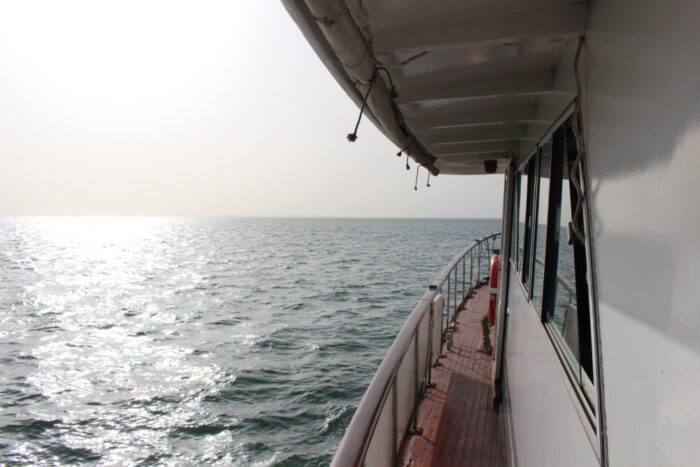
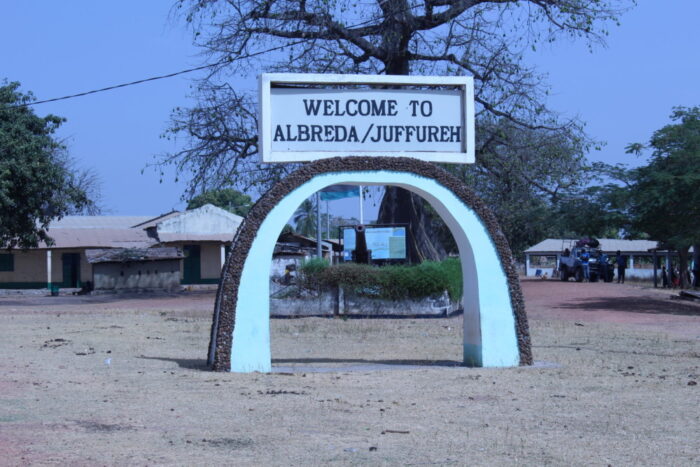
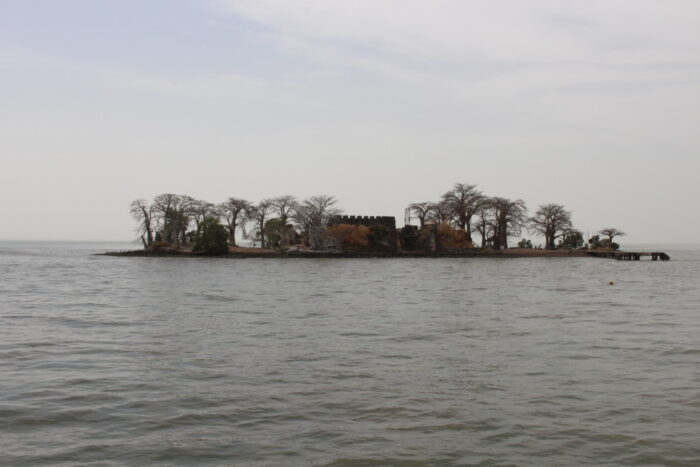
Juffureh Day Trip: Roots
As mentioned above, there are several options for arranging a day tour. We eventually settled on the boat tour offered by the Official tour guides in the Gambia. Their offices can be found in most tourist areas in the country. We went to their office in the Senegambia strip. The tour included entrance to the Slavery Museum; a visit to Juffureh where we met the village elder who told us the story about Kunta Kinteh; a quick look at the local craft market as well as a trip to Kunta Kinteh Island. Most of the day was spent on a boat where we were also served lunch. Various groups participated in the tour in Albreda and Juffureh.
The day started with the guide and driver picking us up at the hotel. We drove to the harbor in Banjul where we boarded the boat that would take us a few kilometers upstream on the Gambia river.The journey took approximately 2 hours before we reached the pier at the village of Albreda.
The Slavery Museum at Albreda was especially fascinating. It was small and quite dusty, but informative. In our case, coming from northern Europe, we had of course heard about the slavery in history class and read about it in books, but it’s not a topic that had touched us closely. The experience at the museum really gave us a completely new outlook on this period of time. I would also say that together with the half an hour or so spent on beautiful Kunta Kinteh Island, the visit to the museum was what touched me. On that calm and sunny February day, it was truly difficult to imagine all the horrors that had taken place on that very spot.
In the village, we were greeted by singing children asking for money and their mothers trying to sell us all kinds of stuff. Taking into account the situation in the Gambia, it was no surprise, but from a learning-perspective, the silent museum sites were more impressive. It was, however, interesting to hear the stories of the village elder and see the village.
If you look at the Gambia river you will certainly see some of the traditional wooden boats, which are really colorful. It was one of these boats that met us and helped to transfer us from our boat – which had taken us up the River but was too big to enter the island – the last meters to the Kunta Kinteh Island. Just entering one of the boats was an experience.
During our trip upriver we had the pleasure to spend the day with two lovely British ladies. These ladies had also made sure that the three of us still had our seats when we came back to the boat from our visit to the Kunta Kinteh Island.


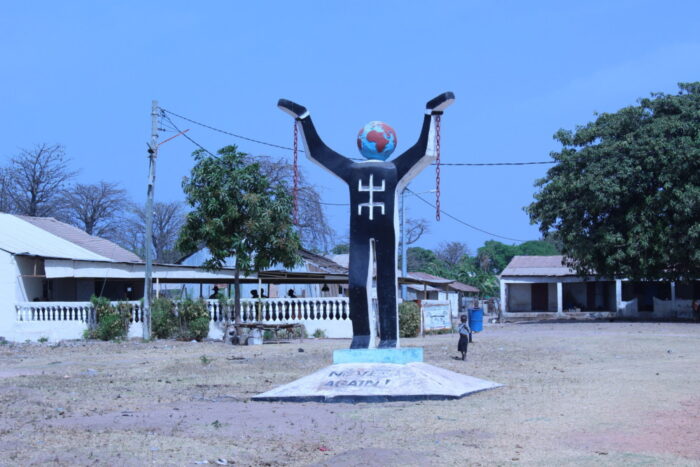
Some Facts About the Slave Trade In the Gambia
The Gambia river played an important role in the slave trade to America. As in many other places in West Africa, a lot of slaves were forced away from their home villages for a new life in the Americas. The Dutch, the Portuguese, the French, and the British were all active around the Gambia River. There were several trade stations built along the river, including Juffureh, Albreda, and James Island.
The Kunta Kinteh Island has had several owners. The first Europeans to settle the island were from the Duchy of Courland and Semigallia, a part of the Polish–Lithuanian Commonwealth. It was then briefly held by the Dutch before the British took over in 1661. After that also the French held the island for a few years. The island houses a fort, Fort James, which was initially used for gold and ivory trade, and later slave trade. The name of the island was changed from James Island to Kunta Kinteh Island in 2011. And Kunta Kinteh? According to Wikipedia, he was one of 98 slaves that in 1767 the slave ship Lord Ligonier brought to Annapolis, Maryland.
Slave trade became illegal in the British Empire at the beginning of the 19th century after the passing of the Slave Trade Act in 1807. The trade did not, however, cease immediately. Instead, it was more uncontrolled and more dangerous than ever before. As a result of this, the British tried to enforce their embargo on the slave trade by using the batteries (the Six-Gun Battery and Fort Bullen) built on both sides of the mouth of the Gambia river to bombard any ship trying to pass through. All these constructions are included James Island UNESCO World Heritage Site.
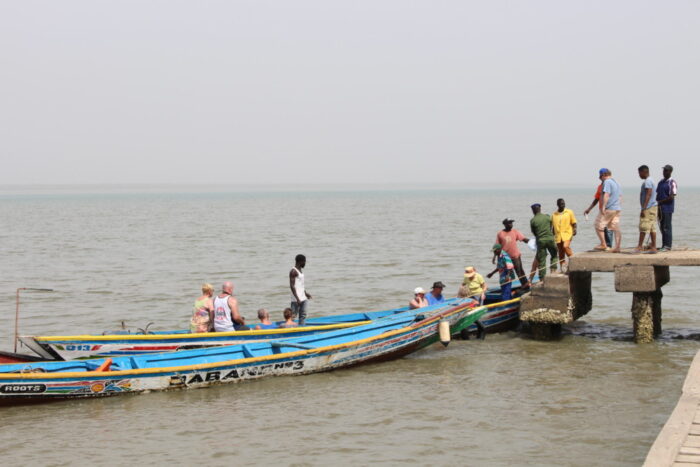


Our Guide Bamba and the Others
As we booked the trip with the official tourist guides, we had one person guiding us and helping us out during the day. Our guide’s nickname was Bamba. He made sure that we wouldn’t miss anything during the day. In addition to informing us about where to be one to both get food first and to get the best views. The other guides that were assisting different clients on the boat were helping not only their own clients but also the rest of us on board. We had our own guide for the day. The atmosphere was really friendly and helpful. There were also guides and military personnel in Albreda and Juffureh to guide us around.
Tourism is essential for the Gambian economy and there is military personnel stationed to look after the tourists. We were surprised how very friendly and talkative they were. They are a good source if you want to learn more about the country by someone who will not ask you for money for telling you about their story.


Juffureh Day Trip: Summary
In summary, I’d say that our day trip Albreda, Juffureh, and the Kunta Kinteh Island was interesting. It was the perfect combination of sunshine, being outdoors, and history. What struck us slightly odd is that most things seemed to come with a price tag, especially in the village where everything was being sold. Seeing the children beg for money was heartbreaking. It’s probably normal procedure when bigger tourist groups arrive but we were not prepared for this at all. The service was great and the guides were fantastic!
